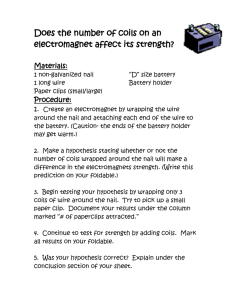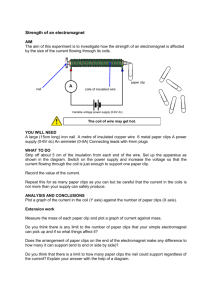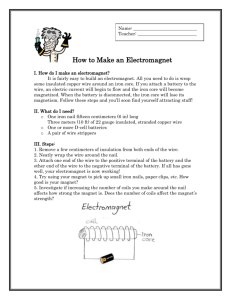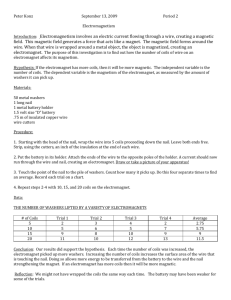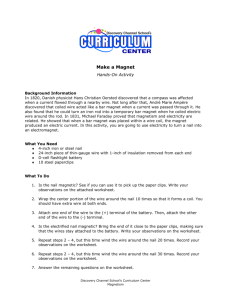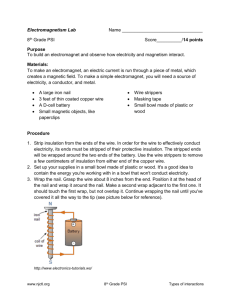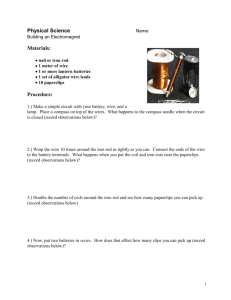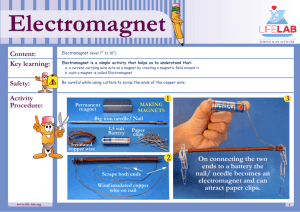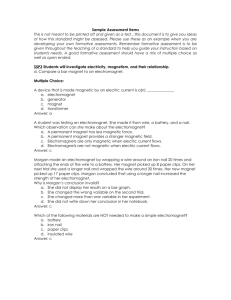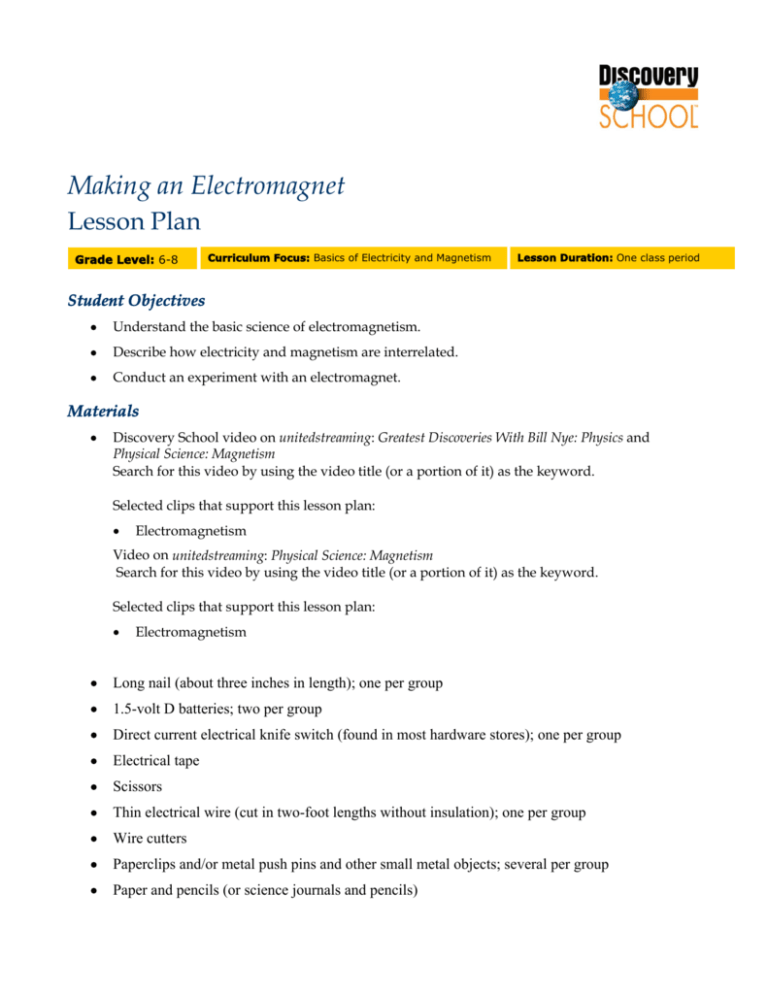
Making an Electromagnet
Lesson Plan
Grade Level: 6-8
Curriculum Focus: Basics of Electricity and Magnetism
Lesson Duration: One class period
Student Objectives
Understand the basic science of electromagnetism.
Describe how electricity and magnetism are interrelated.
Conduct an experiment with an electromagnet.
Materials
Discovery School video on unitedstreaming: Greatest Discoveries With Bill Nye: Physics and
Physical Science: Magnetism
Search for this video by using the video title (or a portion of it) as the keyword.
Selected clips that support this lesson plan:
Electromagnetism
Video on unitedstreaming: Physical Science: Magnetism
Search for this video by using the video title (or a portion of it) as the keyword.
Selected clips that support this lesson plan:
Electromagnetism
Long nail (about three inches in length); one per group
1.5-volt D batteries; two per group
Direct current electrical knife switch (found in most hardware stores); one per group
Electrical tape
Scissors
Thin electrical wire (cut in two-foot lengths without insulation); one per group
Wire cutters
Paperclips and/or metal push pins and other small metal objects; several per group
Paper and pencils (or science journals and pencils)
Making an Electromagnet
Lesson Plan
2
Computer with Internet access (optional)
Procedures
1. Use the videos to explore the basics of electromagnetism. Once you have watched the clips, ask
students to talk about the ways they use electricity and electromagnetism in their everyday
lives. What would life be like without electricity? How does electromagnetism work?
2. Tell students they are going to create an electromagnet of their own to prove that
electromagnetism works. Divide them into groups of three and give each group the materials
necessary for the science experiment. Keep a set of materials for yourself so that you can
demonstrate as you give verbal instructions to the class.
3. Have students use the nail like a magnet to try and pick up or move the paper clips and other
metal objects. What happens? Why can’t the nail move the paper clips?
4. Have students wrap the wire in tight coils around the nail. (Make sure students make about 50
coils around each nail or the electromagnet may not work.) Next, cut both ends of the wire,
leaving a few inches free on either end. Have students keep the pieces of wire they cut off the
nail for later use.
5. Show students which pole on a battery is positive (+) and which is negative (—). Explain that
these two poles work together to complete a magnetic circuit. Once students determine the
poles on the battery, have them use electrical tape to attach the wire from one end of the nail to
the negative pole on one battery. Remind students to make sure that the wire is actually
touching the negative pole on the battery before taping it in place.
6. Have students tape one of the short sections of wire they cut from the nail to the positive pole
on the battery they just used. Next, have them tape this wire to the negative pole on the second
battery, again making sure the wire is touching the battery poles before taping it down. Have
students tape a second small piece of wire to the positive pole on the second battery and leave
the other end free for now.
7. Demonstrate what the knife switch looks like when the switch is in the open position. Ask
students to tape the wire from the free end of the nail (the end that is not attached to the
battery) to the terminal on the knife switch. Have students tape the free end of the wire from the
second battery to the other side of the knife switch terminal. At this point, ask students to leave
the circuits alone. Make sure they do not flip the switch closed on the knife switch.
8. Before closing the knife switch, ask students to predict what they think will happen to the nail
when the switch is flipped. Will it look different? Will it be able to pick up the paper clips? Give
students a few minutes to write their predictions in their science journals or on a piece of paper.
While they are writing, check to make sure groups have set up their circuits correctly.
9. Once they have finished writing down their predictions, have students flip their switches to
close the circuits. What happened? Did anything change? Keeping the circuit intact, have them
again try to pick up or move the paper clips and/or other small metal objects. What happens
now? What has changed?
Published by Discovery Education. © 2005. All rights reserved.
Making an Electromagnet
Lesson Plan
3
10. Explain that when the electric current from the batteries runs through the wire coiled around
the nail, it creates a magnetic field. Because the wire carrying the electricity is coiled, the
magnetic field twists and the magnetic lines concentrate inside the coil, similar to the effect that
occurred in the Bill Nye program. This is how an electromagnet is created.
11. Give students a chance to experiment with their electromagnets. How many paper clips can
their electromagnet pick up? Have them experiment with removing a battery from the circuit.
How does this change the electromagnet? See what happens if you remove the nail from the
circuit and try to pick up the paper clips this way.
12. Once students have finished experimenting, ask them to write a conclusion in their science
journals or on a separate piece of paper. Was their prediction accurate? What happened to the
nail once the electric current started flowing? How does an electromagnet work? How is this
energy used in everyday lives? If there is time, allow them to use the following Web sites to
learn more about electromagnetism:
S-Cool! Electromagnetism
http://www.scool.co.uk/topic_quicklearn.asp?loc=ql&topic_id=8&quicklearn_id=2&subject_id=16&ebt=&ebn=&
ebs=&ebl=&elc
Internet Plasma Physics Education Experience: Electricity and Magnetism
(requires Shockwave)
http://ippex.pppl.gov/interactive/electricity/
How Stuff Works: Electromagnets
http://www.howstuffworks.com/electromagnet.htm
Georgia State University: Bar Magnet
http://hyperphysics.phy-astr.gsu.edu/hbase/magnetic/elemag.html
Assessment
Use the following three-point rubric to evaluate students' work during this lesson.
3 points: Students were highly engaged in class discussions and during the electromagnet
experiment; followed directions and worked well in groups; wrote a prediction about the
nail and the circuit before beginning their experimentation; and wrote a conclusion at the
end of the experiment that demonstrated a solid understanding of how electromagnetism
works.
2 points: Students were engaged in class discussions and during the electromagnetic
experiment; followed directions and worked well in groups with little outside help; wrote a
prediction about the nail and the circuit before beginning their experimentation; and wrote a
conclusion at the end of the experiment that demonstrated the beginnings of an
understanding of how electromagnetism works.
1 point: Students participated minimally in class discussions and during the electromagnet
experiment; were unable to work in groups or follow directions without constant teacher
supervision; did not write a prediction; and wrote an incomplete or incoherent conclusion
that demonstrated a lack of understanding of how electromagnetism works.
Published by Discovery Education. © 2005. All rights reserved.
Making an Electromagnet
Lesson Plan
Vocabulary
current
Definition: A flow of electric charge or the rate of that flow
Context: When the magnet and the wire move near each other, an electric current passes
through the wire.
electricity
Definition: a fundamental form of kinetic, or potential, energy created by the movement of
charged particles, such as electrons
Context: In 1831, a former bookbinder named Michael Faraday proved that a magnetic field
could create electricity.
electromagnet
Definition: A core of magnetic material surrounded by a coil of wire through which an electric
current is passed to magnetize the core
Context: Electromagnets are used in doorbells, loudspeakers, electric motors, and to lift large
amounts of magnetic materials, such as scrap iron.
entropy
Definition: A measure of the amount of energy in a physical system that cannot be used to do
work
Context: German physicist Rudolf Clausius coined the term entropy to explain why the
efficiency of a steam engine is limited.
generator
Definition: A machine that converts mechanical energy into electrical energy
Context: In its most basic form, an electric generator is a coil of wire between the poles of a
magnet.
magnetism
Definition: the phenomenon of physical attraction for iron observed in magnets, inseparably
associated with moving electricity and characterized by fields of force
Context: Scientists have figured out how to create magnetism with electricity by running an
electric current through loops of wire.
Academic Standards
National Academy of Sciences
The National Academy of Sciences provides guidelines for teaching science in grades K–12 to
promote scientific literacy. To view the standards, visit this Web site:
http://books.nap.edu/html/nses/html/overview.html#content.
Published by Discovery Education. © 2005. All rights reserved.
4
Making an Electromagnet
Lesson Plan
5
This lesson plan addresses the following national standards:
Science as Inquiry: Understanding about scientific inquiry
Physical Science: Chemical reactions; Motions and forces; Structure of atoms; Interactions of
energy and matter
Science and Technology: Understanding about science and technology
History and Nature of Science: History of science; Historical perspectives; Science as a
human endeavor
Mid-continent Research for Education and Learning (McREL)
McREL's Content Knowledge: A Compendium of Standards and Benchmarks for K-12
Education addresses 14 content areas. To view the standards and benchmarks, visit
http://www.mcrel.org/compendium/browse.asp
This lesson plan addresses the following national standards:
Science—Physical Sciences: Understands forces and motion; Understands the sources and
properties of energy; Understands the structure and properties of matter; Understands the
composition and structure of the universe and the Earth's place in it
Science—Nature of Science: Understands the nature of scientific knowledge; Understands
the nature of scientific inquiry
Language Arts—Viewing: Uses viewing skills and strategies to understand and interpret
visual media
Historical Understanding—Understand the historical perspective
Technology—Understands the relationships among science, technology, society, and the
individual
Support Materials
Develop custom worksheets, educational puzzles, online quizzes, and more with the free teaching tools
offered on the Discoveryschool.com Web site. Create and print support materials, or save them to a
Custom Classroom account for future use. To learn more, visit
http://school.discovery.com/teachingtools/teachingtools.html
Published by Discovery Education. © 2005. All rights reserved.


